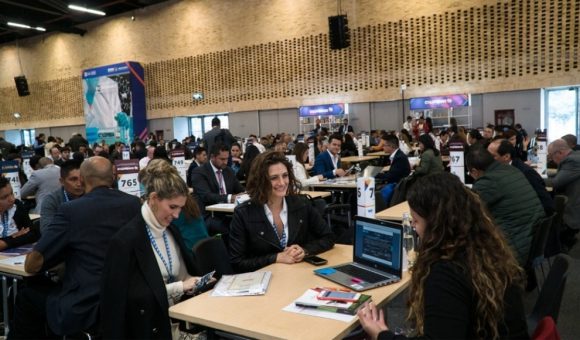‘Responsible Mining’ Dominates Colombia Gold Symposium in Medellin

While Colombia’s gold-mining sector historically has too-often suffered from environmental destruction, violence, land invasions, intromission of guerilla/criminal groups and loud protests from non-governmental organizations (NGOs) and citizens, Antioquia is starting to show real progress in socially and environmentally responsible mining.
In numerous presentations to the first-annual Colombia Gold Symposium November 15-16 in Medellin – attended by roughly 200 corporate delegates and organized by British expat and mining journalist Paul Harris – “responsible mining” emerged as a crucial factor that can enable further investment, expand social-economic development, provide good jobs, boost government tax/royalty revenues and simultaneously protect the environment.
However, exploration and mining companies also need better clarity on Colombian national and local mining controls, speedier regulatory decisions on proposed permits, and a continuation of the recent rebound in global gold prices in order to expand their investments in responsible mining, according to expert speakers here.
While some 85% of the gold produced in Antioquia today comes from illegal and criminal mining – resulting in toxic mercury contamination of water supplies and fisheries, destruction of riverside habitats and forests, government tax losses and massive money-laundering by narco-trafficking gangs — this situation can change for the better with further investment by responsible companies, by legalization campaigns for informal miners (“baraqueros”), by social investments, and by much-better policing controls, according to expert presentations here.
But there’s a new fly in the ointment: A February 8, 2016 decision by Colombia’s Constitutional Court tightened restrictions on mining in highland areas that now have an expanded definition of “paramos” – and related court decisions have thrown into doubt exactly where, when and under what authority mining can take place.
These decisions have already resulted in project delays, monetary losses and new hesitations by both foreign and domestic investors, according to expert speakers here.
As AngloGold Ashanti mining executive Nick Wines explained to Medellin Herald, miners cannot spend tens of millions or hundreds of millions of dollars investing in exploration and development projects in Colombia – counting upon stable rules and licenses controlled by the national government – only to have local or Constitutional judges or territorial governments change the rules mid-course, wiping-out huge investments.
While local and territorial governments and local citizens can and should be consulted prior to approval of mining licenses – with prior consultations also required in certain indigenous/Afro reservation areas even for low-impact exploration licenses — these processes usually ought to involve routine land-use planning, rather than hitting companies with surprise, after-the-fact, ad-hoc and arbitrary legal decisions, according to expert speakers here.
Yet despite recent legal complications, several companies here touted big new investments, development projects and successes in new or continuing gold-mining projects in Antioquia – thanks in large part to their strong “social investments” and vastly improved communications with local populations.
What’s more, new investments by socially responsible miners are likely to grow in future, thanks to some especially promising geological discoveries along with improved technologies, they added. In addition, several companies highlighted promising new projects in Antioquia and elsewhere in Colombia involving joint copper-and-gold production.
Among the leading companies highlighting projects here:
1. Mineros SA. This Medellin-based gold-mining giant – well-known for its environmentally and socially responsible mining practices (see “Mineros SA Boosting Environmental, Social Projects: Heart of Gold,” Medellin Herald, March, 21 2016) – revealed here that it aims to boost gold production to 500,000 ounces per year by 2020, more than double its current production.
In Colombia, Mineros employs a relatively novel, barge-based alluvial mining technique (without using toxic mercury), and recently expanded operations beyond Antioquia into Nicaragua, the latter project involving underground mining. The company is eyeing expansions elsewhere in Central America as well as Mexico, Peru, Argentina and Colombia, according to Eduardo Flores, vice president of business development.
Some 2,000 families living near its El Bagre, Antioquia mining operations have benefited from housing, apiculture (bee-keeping/honey production), fish restocking, wetlands recovery and reforestation projects – all sponsored by Mineros. “Mining can be sustainable,” Flores added, contradicting critics that fail to distinguish between responsible mining and irresponsible mining.
While Colombia is among the top global destinations for gold-mining and exploration companies, “we’re at an incipient level now. We need to get inside problems and work with stakeholders,” Flores said, adding that over the next six months, Mineros “will have something new to discuss in Colombia with a community” that could benefit from responsible mining development.
“We have a model for the artisanal miners in Colombia. We can lead and teach them to prepare for working for the future,” he added.
2. Red Eagle Mining. This Canada-based company with a Peruvian stock-exchange listing just completed its first pour of gold from its brand-new mine and processing plant at Santa Rosa, Antioquia — and expects to launch full production in first-quarter 2017.
Red Eagle co-founder and chief operating officer Bob Bell bragged here that this new operation is “Colombia’s first modern gold mine” with all the latest technology, including a cyanide destruction unit that will help ensure environmentally friendly tailings and also safe discharge of byproduct water.
“Doing business in Colombia involves complex permitting, but that’s no different from elsewhere in the world,” Bell said. “Stick to the rules, don’t complain. You can work your way through them,” he said, adding that country manager Rafael Silva “led our political and social” endeavors, which were “crucial to get through the red tape.”
Red Eagle wisely tapped local universities rather than international consultants to undertake studies required to obtain the environmental permit, which studies totaled some 3,000 pages. The company also worked extensively with the local Santa Rosa community – even prior to exploration efforts — to explain key details of the project, its potential impacts, its environmental safety features and economic benefits, he said.
The company also sought regular feedback from the environmental agency as it developed the environmental studies, well in advance of delivering the final report.
While financing restrictions limit growth for Red Eagle, its 92% ownership of affiliate CB Gold “is our vehicle for future activities” in Colombia, he said. “We see huge potential here,” he added.
3. Continental Gold. This Canada-based company is “very close to construction” of a US$600 million, environmentally and socially responsible mining and processing project at Buritica, Antioquia, which would double Colombia’s legal gold production, according to Continental president Mateo Restrepo.
Continental recently completed its first “sustainability” report outlining its environmental and social efforts at a project that’s expected to average 253,000 ounces per year of gold production over a predicted 14-year mine life (see “Continental Gold Boosts Investment in Socially Responsible Mining in Antioquia,” Medellin Herald, September 27, 2016).
The Buritica project earlier won a “Pines” declaration as a strategic national project from the Colombian government. The company estimates a relatively low US$600/ton all-in cash cost of production, with “big potential” for expansion, as the company has title to another 60,000 hectares nearby in addition to the 2,000 hectares at the current site.
While the Buritica site hasn’t been occupied or controlled by FARC guerillas in several years, it did suffer from a massive invasion of 9,000 illegal miners starting in 2015, which required a “huge government-led intervention” to remove those miners between April and October 2016 – a move that won praise from the local community.
“This was a model on how government should address illegal mining,” Restrepo said. Thanks to careful planning and preparations over two months — including human-rights training of military – “not one shot was fired,” while a local charitable organization “took care of families” related to the miners.
“Still, we have a long way forward,” Restrepo cautioned. “We need continuous military support until the situation is resolved. We need the rule of law, and we need to strengthen local government – including national government funding for social needs” as well as miner technical education and formalization, economic substitution programs and environmental remediation of the old, illegal mines.
4. Gran Colombia Gold. This Canada-based company, which took-over the former Frontino Gold Mines assets in Segovia, Antioquia, today is Colombia’s largest gold/silver producer, with 170,000 ounces produced in 2015, as explained here by Alessandro Cecci, vice president of exploration.
While this mine has been operating almost contiuously for more than 150 years, there’s a lot more production potential, Cecci explained, showing numerous drawings of potentially rich mine plays around the area.
“Even if the Segovia operation is really old, it is still a little baby in terms of exploration,” he added.
However, the Segovia operations have suffered from many years of labor disputes and strikes by local miners. Among the disputes: assertions that the former Frontino Mines owners had essentially given-away certain irregular mining rights to some local operators – mines that have never been formalized or granted permits or titles.
However, a recently restarted “Mesa Minera” dialogue – including participation by the Government of Antioquia — has been making progress in sorting-out various conflicting claims, including disputes over share-of-profit terms between contract miners and Gran Colombia, as well as length of labor contracts, as noted in a recent report from local newspaper, El Colombiano.
5. AngloGold Ashanti: This South Africa-based company has had mixed success with its two main gold-mining projects in Colombia: the legally tied-in-knots “La Colosa” project in Tolima, and the much-more-advanced, legally viable Gramalote project in Antioquia.
The proposed open-pit Gramalote project – near the town of San Roque — is a joint venture between AngloGold (51%) and Vancouver-based B2Gold (49%), and “ is expected to be the group’s first operating gold mine in Colombia, establishing its operating credentials in the country,” according to AngloGold.
The COP$2.4 trillion (US$763 million) project – due for start-up around 2021 — is expected to yield about 3.6 million ounces of gold. The Colombian government earlier declared this mine as a strategic “Pines” project in 2013.
AngloGold obtained its environmental license for the project in December 2015. In the run-up to obtaining that license, AngloGold wisely employed exhaustive surveys with local families near the proposed mine to determine their concerns – crucial for winning subsequent permit approvals.
The company also produced a detailed environmental impact summary (EIS, see link here) explaining how the company would undertake proper disposal of tailings, ensure clean discharge water and destroy byproduct cyanide used in processing.
Some 173 families would be displaced by the project. But a resettlement plan (“Plan de Accion de Reasentamieto”) would guarantee equal or better housing and work conditions for the displaced residents, according to the EIS.
The EIS also includes a detailed closure plan that promises to rehabilitate and restore all areas affected by the operation once the economic life of the mine has ended.
“The closure includes the implementation of measures such as the dismantling of facilities, physical and chemical stabilization of affected soils in the mining process, chemical stabilization of the waters involved in mining activities and processes, and the replanting of areas intervened by the activity,” according to the EIS.
















